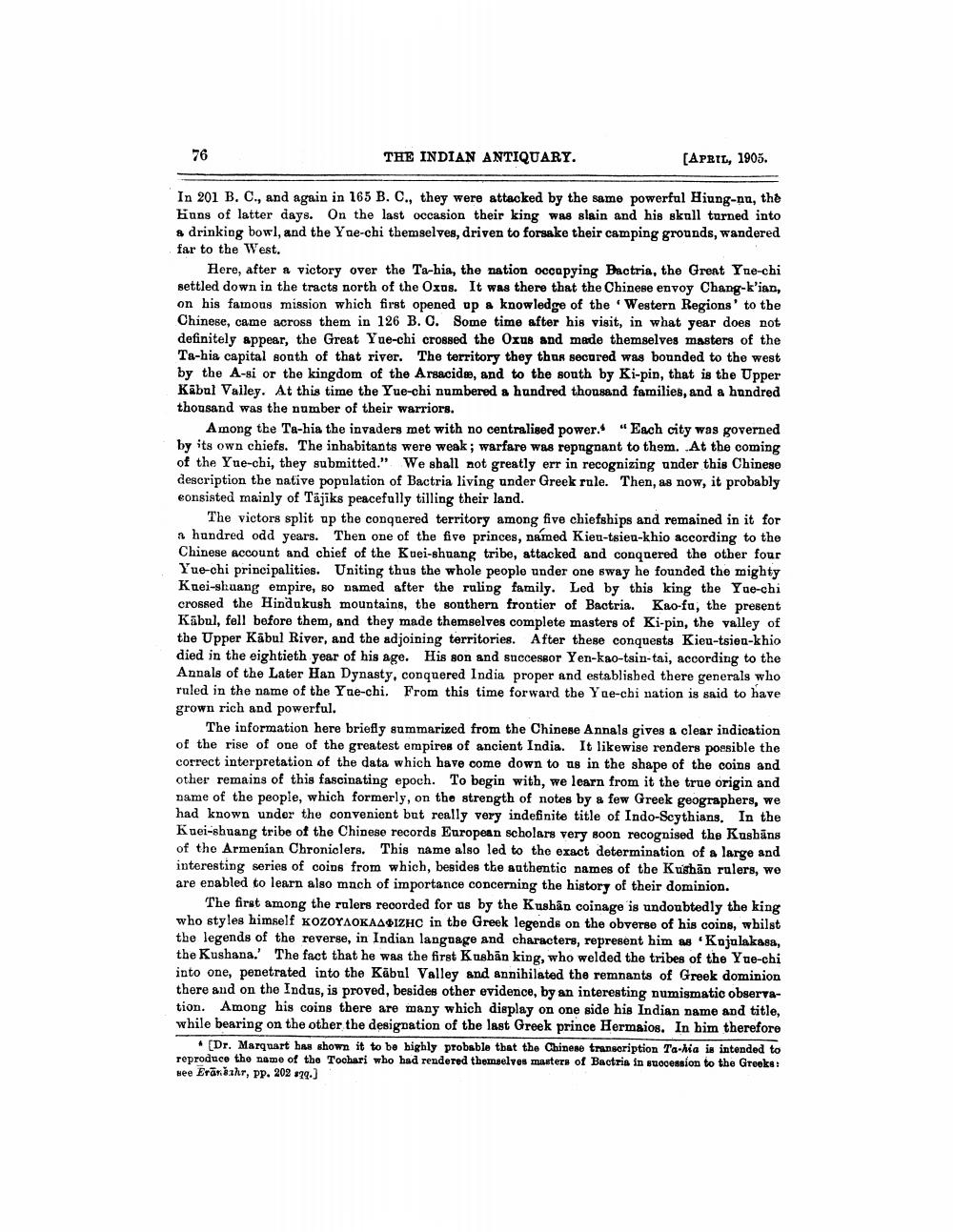________________
THE INDIAN ANTIQUARY.
In 201 B. C., and again in 165 B. C., they were attacked by the same powerful Hiung-nu, the Huns of latter days. On the last occasion their king was slain and his skull turned into a drinking bowl, and the Yae-chi themselves, driven to forsake their camping grounds, wandered far to the West.
76
[APRIL, 1905.
Here, after a victory over the Ta-hia, the nation occupying Bactria, the Great Yne-chi settled down in the tracts north of the Oxus. It was there that the Chinese envoy Chang-k'ian, on his famous mission which first opened up a knowledge of the Western Regions' to the Chinese, came across them in 126 B. C. Some time after his visit, in what year does not definitely appear, the Great Yue-chi crossed the Oxus and made themselves masters of the Ta-hia capital south of that river. The territory they thus secured was bounded to the west by the A-si or the kingdom of the Arsacids, and to the south by Ki-pin, that is the Upper Kabul Vailey. At this time the Yue-chi numbered a hundred thousand families, and a hundred thousand was the number of their warriors.
Among the Ta-hia the invaders met with no centralised power. "Each city was governed by its own chiefs. The inhabitants were weak; warfare was repugnant to them. At the coming of the Yue-chi, they submitted." We shall not greatly err in recognizing under this Chinese description the native population of Bactria living under Greek rule. Then, as now, it probably consisted mainly of Täjiks peacefully tilling their land.
The victors split up the conquered territory among five chiefships and remained in it for a hundred odd years. Then one of the five princes, named Kieu-tsieu-khio according to the Chinese account and chief of the Kuei-shuang tribe, attacked and conquered the other four Yue-chi principalities. Uniting thus the whole people under one sway he founded the mighty Kuei-shuang empire, so named after the ruling family. Led by this king the Yue-chi crossed the Hindukush mountains, the southern frontier of Bactria. Kao-fu, the present Kabul, fell before them, and they made themselves complete masters of Ki-pin, the valley of the Upper Kabul River, and the adjoining territories. After these conquests Kieu-tsien-khio died in the eightieth year of his age. His son and successor Yen-kao-tsin-tai, according to the Annals of the Later Han Dynasty, conquered India proper and established there generals who ruled in the name of the Yue-chi. From this time forward the Yae-chi nation is said to have grown rich and powerful.
The information here briefly summarized from the Chinese Annals gives a clear indication of the rise of one of the greatest empires of ancient India. It likewise renders possible the correct interpretation of the data which have come down to us in the shape of the coins and other remains of this fascinating epoch. To begin with, we learn from it the true origin and name of the people, which formerly, on the strength of notes by a few Greek geographers, we had known under the convenient but really very indefinite title of Indo-Scythians. In the Kuei-shuang tribe of the Chinese records European scholars very soon recognised the Kushans of the Armenian Chroniclers. This name also led to the exact determination of a large and interesting series of coins from which, besides the authentic names of the Kushän rulers, we are enabled to learn also much of importance concerning the history of their dominion.
The first among the rulers recorded for us by the Kushan coinage is undoubtedly the king who styles himself KOZOYAOKAA IZHC in the Greek legends on the obverse of his coins, whilst the legends of the reverse, in Indian language and characters, represent him as 'Kujulakasa, the Kushana.' The fact that he was the first Kushän king, who welded the tribes of the Yue-chi into one, penetrated into the Kabul Valley and annihilated the remnants of Greek dominion there and on the Indus, is proved, besides other evidence, by an interesting numismatic observation. Among his coins there are many which display on one side his Indian name and title, while bearing on the other the designation of the last Greek prince Hermaios. In him therefore
[Dr. Marquart has shown it to be highly probable that the Chinese transcription Ta-hia is intended to reproduce the name of the Tochari who had rendered themselves masters of Bactria in succession to the Greeks: see Eranšahr, pp. 202 #29.]




